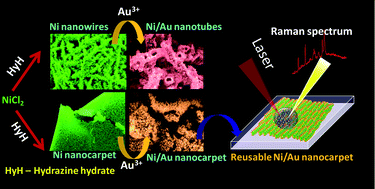Functional hybrid nickel nanostructures as recyclable SERS substrates: detection of explosives and biowarfare agents†
Abstract
We present the synthesis of highly anisotropic nickel

* Corresponding authors
a
DST Unit of Nanoscience (DST UNS), Department of Chemistry, Indian Institute of Technology Madras, Chennai 600 036, India
E-mail:
pradeep@iitm.ac.in
Fax: +91-44 2257-0545
We present the synthesis of highly anisotropic nickel

 Please wait while we load your content...
Something went wrong. Try again?
Please wait while we load your content...
Something went wrong. Try again?
P. R. Sajanlal and T. Pradeep, Nanoscale, 2012, 4, 3427 DOI: 10.1039/C2NR30557G
To request permission to reproduce material from this article, please go to the Copyright Clearance Center request page.
If you are an author contributing to an RSC publication, you do not need to request permission provided correct acknowledgement is given.
If you are the author of this article, you do not need to request permission to reproduce figures and diagrams provided correct acknowledgement is given. If you want to reproduce the whole article in a third-party publication (excluding your thesis/dissertation for which permission is not required) please go to the Copyright Clearance Center request page.
Read more about how to correctly acknowledge RSC content.
 Fetching data from CrossRef.
Fetching data from CrossRef.
This may take some time to load.
Loading related content
